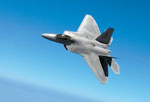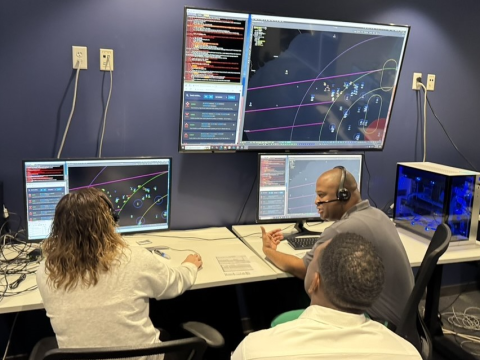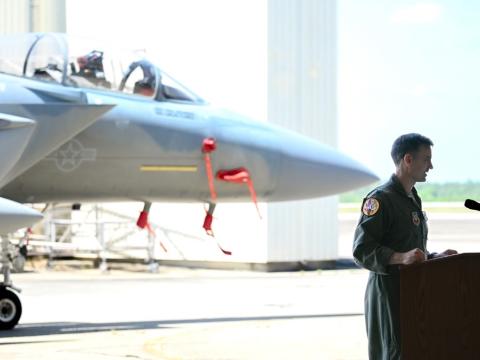Task Force Explores New Military Frontier
 |
| Modern networked platforms such as this F-22 Raptor have capabilities that extend into cyberspace. The F-22’s sensors and systems could be used to deliver virtual attacks, and they also must be protected from such attacks. The goal of the U.S. Air Force’s Cyberspace Task Force is to define the domain for the service to change doctrine and policy to meet changing mission requirements. |
The U.S. Air Force is claiming the virtual high ground. The service recently stood up a task force to study and define exactly what cyberspace means in relation to military operations. This group, part of an ongoing effort to reap the maximum benefits in force transformation, is developing recommendations that will help reshape doctrine, tactics and mission areas for years to come.
Network-centric warfare has become a reality, but the various levels of interaction between warfighters and different sensor, computer and weapons systems are still being refined. Cyberspace, or the networking and information-sharing environment all modern computer and decision-making tools interact with, is a new and still relatively unexplored area for military operations.
The U.S. Air Force launched its Cyberspace Task Force in January to define cyberspace as a mission zone. The task force’s initial goal is to develop a set of recommendations that include developing a strategy for dominance across domains, evolving operational concepts for cyberspace and changing doctrine for these new missions, explains Dr. Lani Kass, the task force’s director, based in
Kass notes that cyberspace represents another theater of conflict for the ongoing war on terrorism in which the
Kass explains that the Air Force is a technology-reliant organization that is especially sensitive to identifying potential cyberspace vulnerabilities and ensuring that they are not exploited. The need to address these issues led the service to commission the task force, which consists of 10 people selected from across the Air Force. Ranging from noncommissioned personnel to senior officers and civilians, these individuals come from a variety of backgrounds and include communications specialists; pilot/navigators; intelligence, surveillance and reconnaissance (ISR) personnel; and air battle management personnel. Task force members are considered intuitive thinkers who are experienced with cyberspace issues.
The task force used a variety of factors to define and illustrate cyberspace as a warfighting domain. But agreeing to a specific definition proved challenging. Kass explains that the group received hundreds of individual opinions and views as it researched, interviewed and analyzed what cyberspace means to the Air Force. Early in the process, she shares, task force members wondered whether any common theme could create a single service-specific picture of cyberspace based on the array of individual perspectives.
After evaluating this data, the task force concluded that cyberspace is a warfighting domain bounded by the electromagnetic spectrum. Kass says that it is inherently technological in nature and possesses unique attributes, advantages and limitations imposed by the physics of its environment. She adds that another way to view cyberspace is as the maneuver space of the electromagnetic spectrum.
Cyberspace affects a variety of related missions such as network warfare and electronic warfare. The group grappled with determining what kinds of systems applied to cyberspace. This consideration was made especially challenging by the multipurpose nature of many military systems. “A network warfare capability is fairly easy to define as being in cyberspace. An ISR resource, on the other hand, may or may not apply depending on context and employment. Some of these questions are still being answered. But by reconciling requirements like these and other considerations, we have arrived at a common definition,” she says.
The task force also identified new and potentially valuable relationships in information technology systems and architectures. Kass believes that some of these interactions may be important to leveraging cyberspace capabilities throughout the Air Force. One relationship is the synergy made possible by harnessing the network-centric aspects of the full range of capabilities present in the service’s terrestrial, airborne and space networks. She notes that the “constellationnet” approach proposed by the Air Force Network Operations Command (AFNETOPs) presents a variety of potential applications that have only begun to be explored. “To sum it up in simple terms, cross-domain dominance equals sovereign operations. By effectively integrating air, space and cyberspace, you create the ability to deliver targeted effects the way you choose anywhere, anytime,” she says.
The Air Force faces several challenges before it can meet its cyberspace goals. The largest hurdle will come as the service transforms itself to meet its current and future needs. “It will be necessary to shatter existing paradigms entrenched in the purely kinetic traditions of warfare while transforming the force into a leader in cross-domain dominance of air, space and cyberspace. It’s about the effects. Namely the effects we can produce in and through cyberspace upon our adversaries,” she maintains.
Such effects can range from simple deterrence to the destruction and defeat of enemy forces. Kass adds that nonkinetic effects do not equate to nonlethal applications. “Just as a kinetic attack can be used merely to terrify rather than kill, nonkinetic attacks can deliver the full spectrum of effects to irritate or cause tremendous loss of life and destruction of property,” she shares.
Kass notes that a commonly overlooked effect used ubiquitously in cyberspace is the ability to detect the enemy. The sensors the Air Force operates globally function in cyberspace and across the electromagnetic spectrum. This detection capability is crucial to all other operations. “Just as with any of the other effects we can instantiate; we can deter, deceive, disrupt, defend, deny and defeat an opponent. The key attribute for each of these is the flexibility with which they can be employed, “ she says.
To explain how the Air Force operates in cyberspace, Kass cites the example of a glass prism. Just as the refractive characteristics of an optical prism can be engineered to achieve effects based on incoming light, the service can manipulate and control the domain of cyberspace through the application of capabilities to achieve specific effects across the electromagnetic spectrum. “The full electromagnetic spectrum becomes our available maneuver space. This allows, for the first time in history, global effects to be delivered at the speed of light, creating virtually instantaneous full spectrum dominance. This domain will only continue to gain in importance, and it is critical that we position the Air Force to fly and fight in cyberspace as a service and in the joint community,” she says.
The importance of cyberspace to the Air Force became official in December 2005 when the service modified its mission statement to include the domain with air and space as an operational area. The task force’s recommendations and implementation framework are being presented to senior Air Force executive staff at its annual gathering, known as
Web Resource




Comments